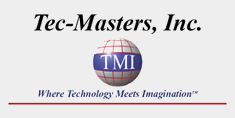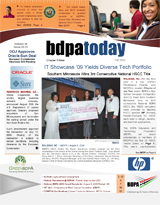|
|
|
bdpatoday
Volume 31 | 10.07.09 |
|
|
|
|
|
bdpatoday blogs, discussions, and
event calendars are enhanced by

2009 Annual Awards Banquet | NOV 12
Reserve tables or tickets today. RSVP on or before October 31.
bdpatoday | online
Missed one? In case we missed you yesterday, our newsletter archives and Acronym of the Day are updated each week for new sponsors, BDPA chapter interest groups (CIGs) and new BDPA members up to the last 100 online editions. Discover more...
New Adobe Flash Tool Does Apple 'End-Around'
Adobe's decision to give Flash developers a way to craft iPhone apps is an "end-around" Apple's decision to ban Flash Player from its popular smartphone.
bdpatoday--Computerworld (CW) reports Adobe's decision to give Flash developers a way to craft iPhone applications is an "end-around" Apple's decision to ban Flash Player from its popular smartphone, an analyst said yesterday.
On Monday, Adobe announced that the next release of Flash Professional CS5, which is to enter public beta by the end of the year, lets developers recompile Flash applications into native iPhone OS code. It also disclosed that seven such applications had been accepted by Apple's App Store, the only sanctioned third-party mart for iPhone software.
"Adobe's doing an end-around because it's in their interest," said Van Baker, an analyst at Gartner. "This is two guys butting heads. Adobe does an end-around to get Flash into the App Store, so from their developers' standpoint, that's a good thing."
For Adobe's point of view, select here to read more...
BDPA & Application Development:
|


CVV
Card verification value (CVV) is a combination of features used in credit, debit and automated teller machine (ATM) cards for the purpose of establishing the owner's identity and minimizing the risk of fraud. The CVV is also known as the card verification code (CVC) or card security code (CSC).
On a typical credit card, there are two components to the CVV. The first code is recorded by the card issuer in a magnetic stripe that runs lengthwise along the back of the card. This stripe resembles magnetic tape and can contain a large amount of data. The code is recovered by sliding the card through a magnetic stripe reader that picks up the binary data in a manner similar to the way a tape drive works. The second code is a multi-digit numeral printed flat on the card, separate from the longer, embossed account numeral. On a VISA, MasterCard or Discover Card, the printed CVV contains three digits and is located on the back near the signature area. On an American Express card, it contains four digits and is located on the front near the embossed account numeral.
When properly used, the CVV is highly effective against some forms of fraud. For example, if the data in the magnetic stripe is changed, a stripe reader will indicate a "damaged card" error. The flat-printed CVV is (or should be) routinely required for telephone or Internet-based purchases because it implies that the person placing the order has physical possession of the card. Some merchants check the flat-printed CVV even when transactions are conducted in person.
CVV technology cannot protect against all forms of fraud. If a card is stolen or the legitimate user is tricked into divulging vital account information to a fraudulent merchant, unauthorized charges against the account can result. A common method of stealing credit card data is phishing, in which a criminal sends out legitimate-looking email in an attempt to gather personal and financial information from recipients. Once the criminal has possession of the CVV in addition to personal data from a victim, widespread fraud against that victim, including identity theft, can occur.
______________________
Source:
Tech Target
|
|
|
|
|
|
|
|
|
2009 Annual Scholarship & Awards Banquet
November 12, 6-9 PM
Washington Navy Yard
Conference Center
Keynote: Cynthia Miller
|
NROTC Scholarships
now on deck @ BDPA!
Cover story in bdpatoday
|
FALL 2009 Print Edition
Download versions available 
|
|
|
|
|
|
About BDPA-DC
NBDPA's Washington, D.C. Chapter was founded in 1978 by Norman Mays. It was incorporated in 1981 as a domestic not-for-profit corporation in the District of Columbia. In February of 1988, Black Data Processing Associates of Washington, D.C. Metropolitan Area (BDPA-DC) became an IRS Section 501(c)(3) Public Charity. Today, BDPA-DC provides professional development services for its members and stakeholders in direct support of local and regional STEM (Science. Technology. Engineering. Math) initiatives. Towards this end, BDPA-DC partners with BDPA Baltimore, BDPA Northern Virginia, and BDPA Richmond to support members and stakeholders within the National Capital Region (NCR) and the Baltimore-Richmond Corridor. BDPA-DC also serves NBDPA, BDPA Chapters and Chapter Interest Groups (CIGs) as a federal news bureau, government relations liaison, and bdpatoday newsletter clearinghouse for emerging NBDPA Chapters.
BDPA-DC
611 Pennsylvania Avenue, S.E., Suite 213
Washington, District of Columbia 20003, USA
|
| Select here to join, sign-up a co-worker, or renew memberships | |
|
bdpatoday ISSN 1946-1429 is published by BDPA-DC and participating NBDPA Chapters.
| |
|